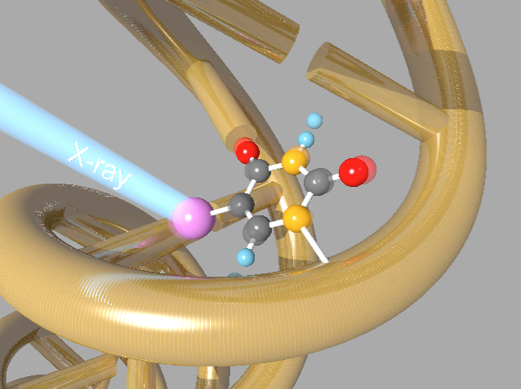NEWS
X-ray free electron laser reveals radiosensitizing effects at molecular level ― The result also validates the methodology for single-shot imaging of bio-systems
 < Image:> Scientists have illustrated how the 5-iodouracil molecule (center) - a nucleobase analogue that forms ribonucleic acid (brown) known as a radiosensitizer - breaks apart shortly after X-ray radiation (blue light), resulting in the local production of 'radiation soup.'
Credit: Image courtesy of Kiyonobu Nagaya, Department of Physics, Kyoto University
< Image:> Scientists have illustrated how the 5-iodouracil molecule (center) - a nucleobase analogue that forms ribonucleic acid (brown) known as a radiosensitizer - breaks apart shortly after X-ray radiation (blue light), resulting in the local production of 'radiation soup.'
Credit: Image courtesy of Kiyonobu Nagaya, Department of Physics, Kyoto UniversityWhile the effect of radiosensitizing molecules in radiation-based cancer therapies has been known for a long time, the exact molecular mechanisms behind it − the capacity of the radiosensitizer to locally augment the radiation damage to tumor cells by intratumoral administration of the agent − are yet to be deciphered.
However, an international team of researchers has illustrated how the molecule breaks apart and what ionic fragments are formed via the breakage of the molecular edifice shortly after the ionization, thus shedding light on the role of energetic ions in the initiation of damaging reactions.
The experiment took place at SACLA, an X-ray free electron laser facility in Japan. Its X-ray pulses are so bright and so brief that they have the ability to strip atomic nuclei, removing so many electrons from the targeted molecules, which then blow up within a tiny fraction of a second. The team succeeded at measuring kinetic energies and directions of the ionic fragments ejected from 5-iodouracil - a nucleobase analogue molecule of biological relevance, whose radiosensitizing effect has been known for a long time. The measurements were fully reproduced by theoretical modelling.
This joint effort of experimental and theoretical investigations, published in the top APS journal Physical Review X, also to be published in RSC's Faraday Discussions, gives clear evidence of the local production of a 'radiation soup' consisting of energetic ions, whose local damage effect adds to that of the genotoxic low energy electrons generated by electronic relaxation cascading mechanisms.
"We expect that the production of 'radiation soup' will contribute to the general understanding of how radiosensitizers work, and hope it will inspire the design of novel radiosensitizing drugs," says Kiyonobu Nagaya of Kyoto University, the lead author of the articles.
"The present study also clearly indicates that at the very early stages of the molecular dynamics following the interaction with the X-ray free electron laser radiation, only hydrogen atoms have time to move significantly, while the bonds between the heavier atoms elongate only slightly," says Kiyoshi Ueda of Tohoku University, who conceived the present study as a principal investigator. "This result validates the methodology for single-shot diffractive imaging of bio-macromolecules by the X-ray free electron laser as a reliable tool."
The result was achieved by an international team of researchers from Japan (Tohoku University, Kyoto University, Hiroshima University, Hiroshima Institute of Technology, Hokkaido University, RIKEN Spring-8 center, JASRI), Finland (University of Turku), United States of America (Kansas State University), France (Synchrotron SOLEIL), China (Beihang University, SARI, SINAP), Korea (POSTECH), and Romania (ELI-NP / IFIN-HH).
Publication details:
Authors: K. Nagaya, K. Motomura, E. Kukk, H. Fukuzawa, S. Wada, T. Tachibana, Y. Ito, S. Mondal, T. Sakai, K. Matsunami, R. Koga, S. Ohmura, Y. Takahashi, M. Kanno, A. Rudenko, C. Nicolas, X.J. Liu, Y. Zhang, J. Chen, M. Anand, Y. H. Jiang, D.E. Kim, K. Tono, M. Yabashi, H. Kono, C. Miron, M. Yao, K. Ueda
Title: Ultrafast dynamics of a nucleobase analogue illuminated by a short intense x-ray free electron laser pulse.
Journal: Physical Review X 6, 021035 (2016).
DOI: 10.1103/PhysRevX.6.021035
Authors: K. Nagaya, K. Motomura, E. Kukk, Y. Takahashi K. Yamazaki, S. Ohmura, H. Fukuzawa, S. Wada, S. Mondal, T. Tachibana, Y. Ito, R. Koga, T. Sakai, K. Matsunami, K. Nakamura, M. Kanno, A. Rudenko, C. Nicolas, X.-J. Liu, C. Miron, Y. Zhang, Y. Jiang, J. Chen, M. Anand, D. E. Kim, K. Tono, M. Yabashi, M. Yao, H. Kono, K. Ueda
Title: Femtosecond charge and molecular dynamics of I-containing organic molecules Induced by intense x-ray free-electron laser pulses
Journal: Faraday Discussions (to be published).
Contact:
Prof. Kiyoshi Ueda
Institute of Multidisciplinary Research for Advanced Materials,
Tohoku University, Sendai 980-8577, Japan
Email: ueda * tagen.tohoku.ac.jp
Phone: +81-(0)22-217-5481
Dr. Kiyonobu Nagaya
Department of Physics, Kyoto University, Kyoto 606-8502, Japan
Email: nagaya * scphys.kyoto-u.ac.jp
Phone: +81-(0) 75-753-3772
Prof. Edwin Kukk
Department of Physics and Astronomy, University of Turku, Turku, FI-20014, Finland
Email: ekukk * utu.fi
Phone :+358 (0) 2 333 6089
Dr. Christophe Nicolas
Synchrotron Soleil, Saint-Aubin, BP 48, FR-91192 Gif-sur-Yvette Cedex, France
Email: christophe.nicolas * synchrotron-soleil.fr
Phone :+33 (0) 1 60 35 96 92
Dr. Catalin Miron (CS1)
Extreme Light Infrastructure - Nuclear Physics (ELI-NP),
"Horia Hulubei" National Institute for Physics and Nuclear Engineering,
30 Reactorului Street, RO-077125 Măgurele, Jud. Ilfov, Romania
Email: catalin.miron * eli-np.ro
Phone : +40 (0) 733 478 778
(Replace * with @)
Posted on:June 17, 2016




